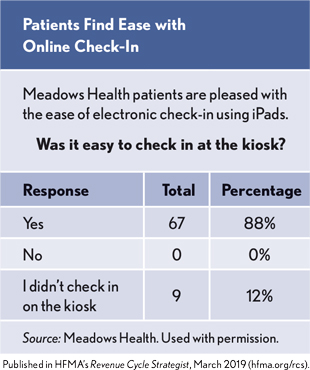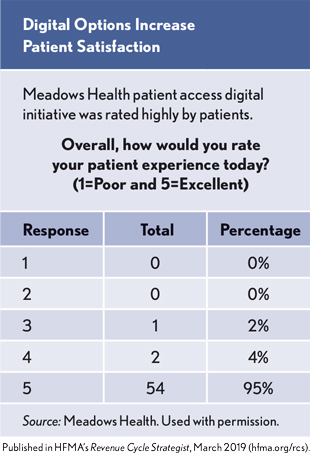Digital Initiative at Meadows Health Improves Patient Communication and Reduces Errors
Consumers are used to managing daily activities from a smartphone, whether shopping or banking online, making appointments, or checking e-mail. Health care, however, is late to the game in clinically and administratively connecting electronically with patients.
For years, we’ve collected patient e-mail addresses and other pertinent data and housed it in an electronic health record (EHR). But we’ve been slow to make the leap to using that information, along with technology, to engage patients in a modern way.
Meadows Health, a regional health system in Georgia, believed its patients were ready for a digital experience using a smartphone or tablet as the communication gateway with their healthcare providers and began the journey in March 2018. Meadows’ vision was to provide patients with contemporary, consistent, digital experiences across its facilities.
Using Technology to Engage Patients
Through a text-based patient survey, the healthcare system learned that up to 40 percent of its patients, especially Millennials, preferred to schedule appointments online, register in advance of their appointments, receive text messages about cost estimates, and even pay using a smartphone.
To provide patients with the conveniences of modern technology, Meadows Health initially addressed the antiquated process of front-desk check-in and use of paper forms filled in by patients with electronic kiosks leveraging iPads in all of its clinics. Patients check in on the iPad, where their visit information is preloaded. A HIPAA-compliant wait board gives them a clear indication of their place in line with their doctor or provider and lets them know how long they have been waiting.

When it is time for patients to register or speak to the nurse for intake, they receive a clear visual and audible signal on the wait board. Patients also receive a text message on their smartphone providing instruction on what to do next, such as bring specific information to the registrar or head to a specific exam room.
While many of their patients are happy to connect with technology, others are still able to communicate in person, over the phone, or via mail.

Benefits of Patient Access Technology
By using the latest in digital engagement technology in the patient access process, Meadows Health has seen the following benefits:
- Connect immediately with patients on their smartphones and tablets
- Improve operational efficiency
- Reduce wait times and data entry errors
- Eliminate the use of clipboards and paper
In the next phase of its digital patient- engagement strategy, patients will be able to provide all non-clinical information before arriving for their appointments. That information will automatically sync to the EHR, eliminating human transcription error and any resulting expenses.
With clipboards eradicated and data entry automated, the health system’s patient access and other front-end revenue cycle teams will be able to:
- Save patient and provider time
- Reduce data entry errors
- Improve patient and family satisfaction
- Minimize the need for patients to interact with call centers by providing self-scheduling and reminders via text message
Results of Technology Investment
Since Meadows Health implemented digital patient-engagement technology, it has seen the following results:
- A 33 percent reduction in year-over-year patient appointment no-shows for its pediatric clinic
- Substantial reduction in no-shows for many other clinics
- Up to 50 percent patient engagement with electronic appointment reminders
Other results of the technology implementation include improvement in the numbers of patients confirming or cancelling scheduled appointments and an increase in filling empty patient slots, thus keeping providers’ schedules full. This results in better resource utilization and higher revenue.
3 Lessons for a Successful Rollout
As with any new process or tool, there’s a learning curve with implementing and rollout of digital patient engagement technology. During this process, the team identified three fundamental lessons:
Partner with physicians in the process. Get their support first by demonstrating positive results for physician practice operations and revenue.
Prepare the team for change. Communicate across the organization well in advance to ensure the vision is understood and shared, and also be prepared to answer the question, “What’s in it for me?” from any staff person. For example, patients can get text alerts telling them their exam rooms are ready and that nurses are on the way. This allows for valuable minutes to be saved in the process. Patients are ready when nurses appear, allowing nurses to spend more time in active conversations and engagement with patients. In addition, administrative staff can save time and effort in manual tasks such as calling to remind patients of their appointments.
Don’t underestimate the complexity of patient communication. There are more variables than you can imagine or anticipate. We uncovered, for example, that text messages needed to be customized based on the type of care setting for patients to easily understand them. We learned that providing a consistent patient experience was not about exact verbiage across all channels, but rather the consistency of processes across care settings. Test repeatedly before implementing broadly to ensure viability of the strategy.
Additional Patient Engagement Plans
During the selection of a digital patient- engagement technology, Meadows Health sought a partner that would collaborate to develop even more interactive capabilities. Although there have been tremendous strides made over the past year, the health system’s goal is continual process improvement.
The next stage of the procedure is to use automation and additional technology-based capabilities to further improve operational efficiency and patient engagement.
The health system plans to improve the patient waiting-room experience using technology to inform patients of an optimal arrival time to reduce wait time and enable them to manage their time more efficiently.
The continued use of advanced technology will also benefit Meadows Health staff by removing unfulfilling, menial tasks from daily work so they can spend more time and energy focused on the comfort and satisfaction of patients.
Finally, the digital patient engagement platform will be used to support other aspects of the revenue cycle, such as automating registration, including eligibility review and error-checking of patient information. This second wave of automation will streamline collections, denials, and boost efficiency in reworking claims.





